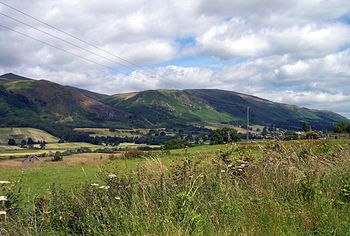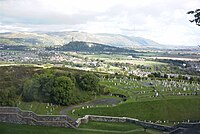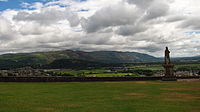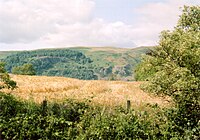Ochil Hills: Difference between revisions
Created page with 'right|thumb|350px|Wood Hill and Elistoun Hill from southwest of Tillicoultry The '''Ochil Hills''' are a long range of hills in the southern part of [[Pe…' |
No edit summary |
||
| (One intermediate revision by one other user not shown) | |||
| Line 1: | Line 1: | ||
[[File:Ochil Hills.jpg|right|thumb|350px|Wood Hill and Elistoun Hill from southwest of Tillicoultry]] | [[File:Ochil Hills.jpg|right|thumb|350px|Wood Hill and Elistoun Hill from southwest of Tillicoultry]] | ||
The '''Ochil Hills''' are a long range of hills in the southern part of [[Perthshire]] and eastern [[Stirlingshire]], and forming a great part of the small counties of [[Clackmannanshire]] and [[Kinross-shire]]. The [[county top]]s of the latter two shires are all in the Ochil Hills. At the edges of the Ochil Hills stand the towns of [[Stirling]], [[Alloa]], [[Kinross]] and [[Perth]]. | The '''Ochil Hills''' are a long range of hills in the southern part of [[Perthshire]] and eastern [[Stirlingshire]], and forming a great part of the small counties of [[Clackmannanshire|Clackmannan]] and [[Kinross-shire|Kinross]]. The [[county top]]s of the latter two shires are all in the Ochil Hills. At the edges of the Ochil Hills stand the towns of [[Stirling]], [[Alloa]], [[Kinross]] and [[Perth]]. | ||
The Ochils are south of the great ranges of the [[Highlands]], separated from them by [[Strathearn]]. To the south is the [[River Forth|Forth]] valley. The [[Lomond Hills]] of [[Fife]] provide an eastward extension of the range. | The Ochils are south of the great ranges of the [[Highlands]], separated from them by [[Strathearn]]. To the south is the [[River Forth|Forth]] valley. The [[Lomond Hills]] of [[Fife]] provide an eastward extension of the range. | ||
| Line 46: | Line 46: | ||
*[[Kings Seat]] (2,126 feet) | *[[Kings Seat]] (2,126 feet) | ||
*[[Greenforet Hill]] (2,021 feet) | *[[Greenforet Hill]] (2,021 feet) | ||
*[[ | *[[Innerdouny Hill]] (2,005 feet) | ||
| | | | ||
*[[Mickle Corum]] (1,949 feet) | *[[Mickle Corum]] (1,949 feet) | ||
Latest revision as of 10:49, 17 June 2014

The Ochil Hills are a long range of hills in the southern part of Perthshire and eastern Stirlingshire, and forming a great part of the small counties of Clackmannan and Kinross. The county tops of the latter two shires are all in the Ochil Hills. At the edges of the Ochil Hills stand the towns of Stirling, Alloa, Kinross and Perth.
The Ochils are south of the great ranges of the Highlands, separated from them by Strathearn. To the south is the Forth valley. The Lomond Hills of Fife provide an eastward extension of the range.
The name "Ochil" is from a Celtic word root comparable to the Welsh uchel meaning 'high'.
The only major roads crossing the hills pass through Glen Devon-Glen Eagles and Glenfarg, the latter now largely replaced except for local traffic by the M90 Edinburgh-Perth motorway cutting through the eastern foothills.
Geography and geology
The hills are part of a Devonian lava extrusion whose appearance today is largely due to the Ochil Fault which results in the southern face of the hills forming an escarpment.
The plateau is undulating with no prominent peak. The highest point is Ben Cleuch in Clackmannanshire at 2,365 feet. The south-flowing burns have cut deep ravines including Dollar Glen, Silver Glen and Alva Glen, often only passable with the aid of wooden walkways.
Historical interest
The place of the hills has had historical importance. Stirling was, before Victorian engineering, the lowest bridging point on the River Forth, and the Ochil Hills provided a natural bastion at this strategic point: thus Stirling was the main gateway to the Highlands. The hills also acted as a boundary to the Kingdom of Fife.
Castle Campbell was built at the head of Dollar Glen in the late 15th century (an earlier castle on the site being called "Castle Gloom"). Castle Campbell served as a very visible symbol of the Campbell domination of the area. Sheriffmuir, the site of a key battle of the Jacobite rising in 1715, is on the northern slopes of the hills.
In the early Industrial Revolution, several mill towns such as Tillicoultry, Alva and Menstrie (the Hillfoots Villages) grew up in the shadow of the Ochils to tap the water power. Some of the mills are open today as museums.

Proposed wind farms
A proposal for an 18 turbine development at Green Knowes, south of Auchterarder, north of Glendevon was approved in June 2006. The development, now complete, stands about 450 yards north of the summit of Ben Thrush.
In early 2007 approval was given for the construction of a wind farm consisting of thirteen 334-foot turbines on Burnfoot Hill, which lies north of Tillicoultry and Ben Cleuch and to the south of the Upper Glendevon Reservoir. Construction of this site has begun.
Hills of the Ochils


Summits of the Ochil Hills include:
|
|
|
References
Outside links
- Photographic Panorama of the Ochils - Ochils panorama on Flickr
- Computer generated summit panoramas:
- Clacksweb - Ochil Hills
- Ochils Mountain Rescue Team
- Ochils Mountaineering Club
- Ochils Landscape Partnership
- Friends of the Ochils